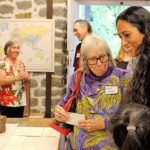KAILUA-KONA — The scent of roasted coffee wafted through the open windows of the H.N. Greenwell Store Museum on Monday in Kealakekua, where still faces from the past waited patiently to tell their tales.
“E Hele Me Ka Puolo: The Gifts We Bring,” the Kona Historical Society’s new exhibit, gets its name from a Hawaiian saying that highlights the practice of carrying a gift wherever one goes as a show of respect and gratitude.
“The exhibit focuses on the cultural diversity of Kona through this idea that we all have brought this gift … with us,” said museum curator Mina Elison. “It looks at the physical things people brought, but more importantly the knowledge, values and traditions people also brought with them.”
Predominantly black and white photographs, physical pieces created by kamaaina artisans with close connections to their ancestral lands, artifacts and oral histories developed from interviews conducted by Elison throughout 12 months comprise the display.
Set against the building’s brick backdrop, countenances of immigrants who came to Hawaii long ago in search of refuge or a better life tell stories of family, work ethic and a special connection to the land.
“One of the things that makes Kona’s story unique, the people that came here were risk takers,” Elison said. “They were looking for opportunity and puuhonua.”
Early Polynesians, Western explorers and missionaries, Chinese and Japanese laborers who came to work sugar plantations, the arrival of Portuguese followed by Koreans and Filipinos as commerce developed, and finally the immigration of Hispanic and Micronesian populations — the exhibit explores the cultural evolution of all these groups in Kona through the art and history of a diverse collection of families whose stories are unique, yet in many ways the same.
A pencil and watercolor piece by Gerald Lucena on homemade wauke/ki paper depicts the colors of the menpachi and opelu, gifts his family of Filipino ancestry would receive in return for flowers they cultivated in their garden.
Also on display is a leiomano, crafted by Conall Kahaka‘io Ravenscraft of Hawaiian descent. He describes the piece as a “tool of sacrifice” that “symbolizes the ancient custom of the ancestors.”
Contrast storytelling through commissioned pieces was an element of curation uncharacteristic of former society exhibits, Elison said.
“To invite specific artists in the community to contribute pieces based on this idea of bringing a gift is new for us,” she explained.
But the collecting of art and conducting of interviews produced a charmingly ironic effect in that the process ended up mirroring the final product in a powerfully symbolic way, Elison added.
“(I was) stunned at people’s generosity — how much they were open to sharing with me and the community, how much thought went into what they created,” she said. “From our concept and idea, we shared it with them and then they ran with it. The community collaboration became a manifestation of the exhibit idea and concept. Everybody kept coming with these gifts.”
Not every aspect of every culture is a gift, however, a truth from which the exhibit doesn’t shy away. Elements of discrimination that accompanied the integration of so many cultures in one place aren’t ignored in the display, though they aren’t the focal point, either.
The public is welcome to view the exhibit from 10 a.m.-2 p.m. Mondays, Tuesdays and Thursdays at the H.N. Greenwell Store Museum in Kealakekua. Price of admission is $7 for adults, $5 for kamaaina, military and senior citizens and $4 for students.
The exhibit runs until the end of June.
Society expansion
The popularity of exhibits such as “E Hele Me Ka Puolo: The Gifts We Bring” made it clear to Kona Historical Society Executive Director Joy Holland during recent years that the organization needs something more.
Come next year, she thinks the society will have it.
The society has plans for a new art gallery to be located at the front of the property, a development Holland said was made possible by a $600,000 state grant. She couldn’t say precisely when ground would be broken, but is confident the gallery should be ready for exhibits by the end of 2019.
“This exhibit program has grown so much and we’ve generated so much interest in it, now we’ll finally have a proper space,” she said.
Outwardly, the gallery’s aesthetic will remain consistent with other buildings on the site, namely the store museum built in the style of an old ranch home from the late 19th century. The interior, by contrast, will be designed using the modern, white-cubed gallery style as a model.
Gallery floor space is expected at about 1,000 square feet and the building will come with a wraparound lanai for use during events. Holland said it also will provide sweeping views of the pasture.
The gallery will be a welcome addition to the museum, historical programs and bread making that already take place on the property, Holland added. Because of the society’s status as a Smithsonian affiliate, the space opens up the possibility for traveling exhibits.
“What Kona has never really been able to do, and actually the island hasn’t been able to do, is have the type of exposure to exhibits for major museums,” she said.
Total cost of construction for the gallery is estimated at about $1.5 million, and some private funds already were procured. Holland said a 2019 capital campaign by the Kona Historical Society is likely to round out necessary funding.
Email Max Dible at mdible@westhawaiitoday.com.






